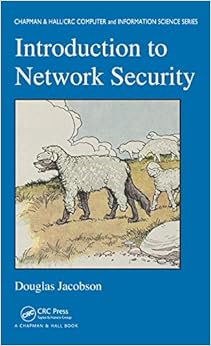
Free Downloads Introduction To Network Security (Chapman & Hall/CRC Computer And Information Science Series)

Unlike data communications of the past, today’s networks consist of numerous devices that handle the data as it passes from the sender to the receiver. However, security concerns are frequently raised in circumstances where interconnected computers use a network not controlled by any one entity or organization. Introduction to Network Security examines various network protocols, focusing on vulnerabilities, exploits, attacks, and methods to mitigate an attack. The book begins with a brief discussion of network architectures and the functions of layers in a typical network. It then examines vulnerabilities and attacks divided into four categories: header-, protocol-, authentication-, and traffic-based. The author next explores the physical, network, and transport layers of each network as well as the security of several common network applications. The last section recommends several network-based security solutions that can be successfully deployed.This book uses a define-attack-defend methodology for network security. The author briefly introduces the relevant protocols and follows up with detailed descriptions of known vulnerabilities and possible attack methods. He delineates the threats against the protocol and presents possible solutions. Sample problems and lab experiments based on the concepts allow readers to experiment with attacks and assess the effectiveness of solutions. Two appendices provide further clarification and a companion website is offered which supplements the material.While most of the books available on this subject focus solely on cryptographic techniques to mitigate attacks, this volume recognizes the limitations of this methodology and considers a wider range of security problems and solutions. By focusing on a practical view of network security and examining actual protocols, readers can better understand the vulnerabilities and develop appropriate countermeasures.

File Size: 9808 KB
Print Length: 500 pages
Simultaneous Device Usage: Up to 4 simultaneous devices, per publisher limits
Publisher: Chapman and Hall/CRC; 1 edition (November 18, 2008)
Publication Date: November 18, 2008
Sold by: Digital Services LLC
Language: English
ASIN: B005H6YE7C
Text-to-Speech: Not enabled
X-Ray: Not Enabled
Word Wise: Not Enabled
Lending: Not Enabled
Enhanced Typesetting: Not Enabled
Best Sellers Rank: #604,080 Paid in Kindle Store (See Top 100 Paid in Kindle Store) #164 in Books > Science & Math > Mathematics > Pure Mathematics > Combinatorics #201 in Books > Computers & Technology > Security & Encryption > Encryption #211 in Books > Computers & Technology > Security & Encryption > Cryptography

This is an absolutely excellent book. It breaks down the basic network layers, their headers and their functions in an easy to understand format. It is not overly verbose and provides just the right amount of examples to give the reader a good understanding of how everything works and fits together. It also provides a good "taxonomy," as the author calls it, for classifying the attacks/mitigation techniques that can be implemented for the different network layers. Lastly and probably most importantly the book is written for some who has no knowledge of computer networking. It does and wonderful job of explaining things leaving the reader with an outstanding understanding of that subject.
Required for a class, but not very useful. Material has inaccuracies, isn't well presented, and unoriginal.
This book was alright. I took a class by this professor and used a draft of the final version of this book. The draft had a few inaccuracies, but that's why it was a draft, I would assume the issues are fixed now. The professor does know his stuff, but you should note that is is an introduction to network and general security. If your new to security and you want to learn a good "taxonomy" for network attacks then this is a good place to start, but I've seen better books on security. There are not many real world examples in this book because it is an introduction and it is assumed the skill set is not there yet, also because real world attacks change very quickly. The assignments recommended in this book are good and the accompanying code on the website is a good starter for getting interested in network security. However if you have any sort of network security experience already I would recommend diving into other books instead.
Introduction to Network Security (Chapman & Hall/CRC Computer and Information Science Series) Introduction to Modern Cryptography: Principles and Protocols (Chapman & Hall/CRC Cryptography and Network Security Series) Introduction to Modern Cryptography, Second Edition (Chapman & Hall/CRC Cryptography and Network Security Series) Computer Graphics Through OpenGL: From Theory to Experiments (Chapman & Hall/CRC Computer Graphics, Geometric Modeling, and Animation) Introduction to Probability (Chapman & Hall/CRC Texts in Statistical Science) Stochastic Processes: An Introduction, Second Edition (Chapman & Hall/CRC Texts in Statistical Science) An Introduction to Partial Differential Equations with MATLAB (Chapman & Hall/CRC Applied Mathematics & Nonlinear Science) Graphics for Statistics and Data Analysis with R (Chapman & Hall/CRC Texts in Statistical Science) Modeling and Analysis of Stochastic Systems, Second Edition (Chapman & Hall/CRC Texts in Statistical Science) Linear Models with R, Second Edition (Chapman & Hall/CRC Texts in Statistical Science) Computational Partial Differential Equations Using MATLAB (Chapman & Hall/CRC Applied Mathematics & Nonlinear Science) An Introduction to Multicomplex SPates and Functions (Chapman & Hall/CRC Pure and Applied Mathematics) Algorithms in Bioinformatics: A Practical Introduction (Chapman & Hall/CRC Mathematical and Computational Biology) Introduction to Computational Biology: Maps, Sequences and Genomes (Chapman & Hall/CRC Interdisciplinary Statistics) A Concise Introduction to Pure Mathematics, Fourth Edition (Chapman Hall/CRC Mathematics) Home Security: Top 10 Home Security Strategies to Protect Your House and Family Against Criminals and Break-ins (home security monitor, home security system diy, secure home network) Image Processing and Acquisition using Python (Chapman & Hall/CRC Mathematical and Computational Imaging Sciences Series) Data Classification: Algorithms and Applications (Chapman & Hall/CRC Data Mining and Knowledge Discovery Series) Numerical Techniques for Direct and Large-Eddy Simulations (Chapman & Hall/CRC Numerical Analysis and Scientific Computing Series) The Garbage Collection Handbook: The Art of Automatic Memory Management (Chapman & Hall/CRC Applied Algorithms and Data Structures series)



